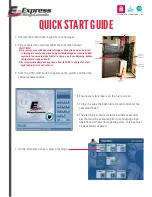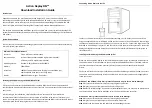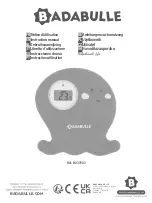
6
Introduction
Your new Verilux
®
CleanWave
®
Sanitizing Wand eliminates up to 99.9% of
viruses (including H1N1), bacteria (including MRSA), germs, mold, dust mite
eggs and fl ea eggs on surfaces.
We hope you enjoy this product and use it frequently.
Your results will
be cumulative – your “kill rate” may be 90% during your fi rst use on a
surface, then “90% of the remaining 10%” on your next use.
About Light and UV-C Light
Visible light is electromagnetic radiation in wavelengths visible to the human
eye. The wavelength of visible light, in nanometers, is about 400nm to 750nm.
A nanometer is one billionth of a standard metric meter.
Ultraviolet or UV light is the part of the electromagnetic spectrum – from
about 10nm to 400nm – that contains frequencies just higher than visible light.
Above ultraviolet rays are X-rays. And above X-rays are gamma rays – the
highest – and highest energy – waves yet found.
Ultraviolet light was discovered by German physicist Johann Ritter. In 1801,
Ritter was experimenting with silver chloride, a chemical known to break
down when exposed to sunlight. He found that light at the blue end of the
spectrum increased the reaction.
Experimenting further, he discovered that the reaction was even more effi cient
when exposed to radiation beyond blue – radiation that was invisible. He
called this new type of radiation ultraviolet, meaning “beyond the violet” (ultra
comes from the Latin for “beyond”).
UV light is invisible to humans, but birds and some species of insects, snakes,
turtles and fi sh can see ultraviolet light.
UV light can be divided into various wavelength bands with differing
characteristics.
The Sun emits ultraviolet radiation in UV-A, UV-B and UV-C bands, but
because of absorption in the ozone layer, 99% of the ultraviolet radiation that
reaches Earth is “long wave” UV-A.
UV-A, also known as “black light,” creates fl uorescent effects at your local
disco and “midnight bowling” sessions as UV light (which cannot be seen) is
absorbed by materials and re-emitted in the visible range.
UV-B “medium wave” rays both help and hurt. Too much UV-B exposure
causes sunburn and can damage human tissue. Too little UV-B exposure
leads to a lack of Vitamin D absorption in animals.
The higher energy “short wave” UV-C band rays (100 to 280 nanometers)
are highly lethal to micro–organisms. This range is known as the Germicidal
Spectrum.


































